Spoiler Warnings for Batman: Arkham Asylum, Batman: Arkham City, and Batman: Arkham Knight. Trigger warnings for violence, poisoning, and death.
Welcome everyone, to my new series! I’m a big video game nerd (shocking, I know) and as I was looking for games to review I stumbled upon an interesting realization. 2011 was actually a pretty damn big year for gaming. Lots of games came out that year that were massively influential, massively successful, or at the very least still loved by many today. So, in honor and recognition of that, let’s just dive right in with one of the biggest games of that big year, Rocksteady‘s Batman: Arkham City.
The Setup
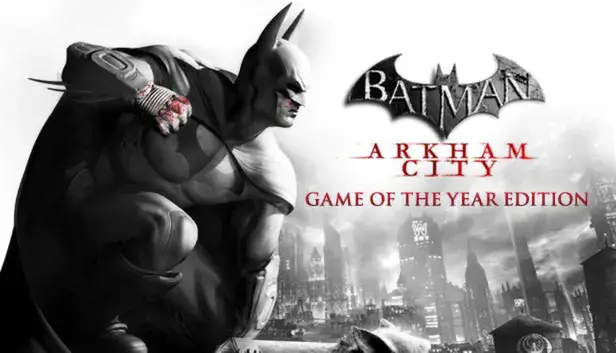
Arkham City came out in 2011, two years after Batman: Arkham Asylum had come out and redefined both the stealth action genre and the superhero game. While it didn’t necessarily invent anything, its stealth hunting segments, and its flowing combat system was cemented into gaming with Asylum. Much of Sony’s Spider-Man game for the PlayStation 4 wouldn’t exist the way it does without the Arkham series, for better or for worse. And it elevated Rocksteady to gaming royalty despite being only their second game (their first was a first person shooter called Urban Chaos: Riot Response largely reviewed as ‘average’). And so it should come as no surprise that two years later a sequel came out, with a bigger map, bigger plot, and more content all around.
The Plot
Arkham City is set eighteen months after the events of the first game. Both Blackgate Penitentiary (where the criminals deemed to be not mentally ill go in Gotham) and Arkham Asylum are in ruins after the Joker’s latest scheme, and the newly elected mayor, former head of Arkham Quincy Sharp, has created the titular Arkham City, a massive open air prison carved out of Gotham’s slums. And, in a right wing dream scenario, all criminals in Gotham go into it. The tax evaders and the petty burglars are put in the same place as the super villains and the serial killers. To make matters worse, the man in charge of the prison, Hugo Strange (Corey Burton, doing a wonderful, Christopher Lee inspired voice) is given carte blanche to toss political prisoners in as well.
Gotham is cold, it’s winter, and this open air prison is low on supplies, clothing, heat sources, and pretty much everything else. And when Bruce Wayne (Kevin Conroy) goes to protest this situation (as well as the fact that the lack of guards on the ground mean everyone’s pretty much free to wage total gang wars) he’s promptly arrested by Strange’s personal army, Tyger. Strange reveals the fact that he knows Bruce is Batman, then has him thrown into the prison, telling him that tonight, something called Protocol 10 will make him famous and Batman forgotten.

Bruce is tossed into the hard streets of Arkham City, but after a short encounter with Penguin he manages to slip away into the Batsuit, letting the game truly begin. His first order of business is saving Catwoman (Grey DeLisle) from Two-Face (Troy Baker), figuring that she likely knows what Strange’s Protocol 10 is. She doesn’t, but mentions some rumors that Joker (Mark Hamill) and Strange are working together. This, coupled with Joker attempting to murder Catwoman via remote sniper sends Batman out to the steel mill Joker and Harley (Tara Strong) have made their fortress.
Things do not go well. Joker manages to get the drop on Batman, knocking him out. When he wakes up, it’s revealed that the serum Joker used in the previous game (Titan, an enhanced version of the chemicals Bane uses) is slowly killing him, a toxin in his blood. He had Mr. Freeze (Maurice LaMarche) working on a cure, but the scientist got captured by Penguin (Nolan North). And while Batman was unconscious the Joker put some of his blood into him, meaning that now he’s dying too. And on top of that, he’s also been shipping his blood out of Arkham City and into hospitals, so if a cure isn’t made soon then there’s going to be mass death across Gotham. He also reveals that he doesn’t know what Protocol 10 is, meaning that now Batman has two plots to contend with.
From there Batman must rush, first to Penguin’s fortified museum, then to the underground base the League of Assassins has beneath Arkham City (foreshadowing) to get a sample of Ra’s al Ghul’s blood (Dee Bradley Baker) as the man’s chemical induced immortality has made his blood a key part of the cure. This brings him into conflict with Talia al Ghul (Stana Katic), Ra’s daughter and Bruce’s lover, but he moves on, getting Freeze to make him a cure. There’s a brief fight between Freeze and Batman (the best boss fight in the franchise and one of the best in all of gaming, requiring careful strategy and constantly changing your tactics) during which Harley Quinn (again, later) steals the cure.
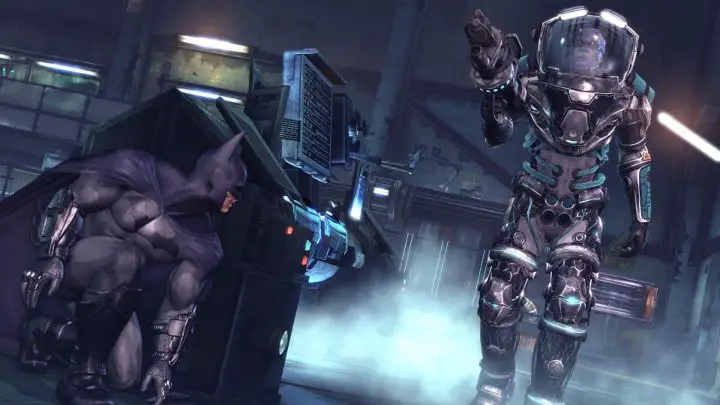
As Batman heads off to retrieve it, he gets taunted by the Joker on video, looking entirely cured and healthy. The two (and a small army of thugs) fight, only to be interrupted by the revelation of Protocol 10. Having secretly fed military grade weapons into Arkham City, Strange has been able to gather ‘evidence’ declaring that the inmates are planning a mass breakout and has gotten permission from the city council to use helicopters and missiles from his tower headquarters to kill all the inmates of Arkham City. This wave of missiles pins Batman under the rubble, trapping him, but Talia intervenes before Joker can kill him, offering the clown immortality and the leadership of the League of Assassins to spare Batman.
Of course Joker accepts, and after being freed from the rubble by Catwoman Bruce attempts to follow them. However, Alfred (Martin Jarvis) and Oracle (Kimberly Brooks) have been advising and commenting this whole time via the Batcave’s com systems and they convince him that Protocol 10 is the priority, which he eventually accepts. From there he has to fight his way up through Strange’s headquarters until eventually confronting the man himself, managing to stop the destruction and revealing that Ra’s was behind Strange the whole time (hence the League being under Arkham City). Ra’s betrays Strange, declaring that he doesn’t give second chances and that Strange failed him, which results in Strange activating a failsafe, making the tower itself explode, with Batman barely managing to escape. He tries to save Ra’s, but the man impales himself on his sword in an attempt to kill Batman too and is thus left to fall.
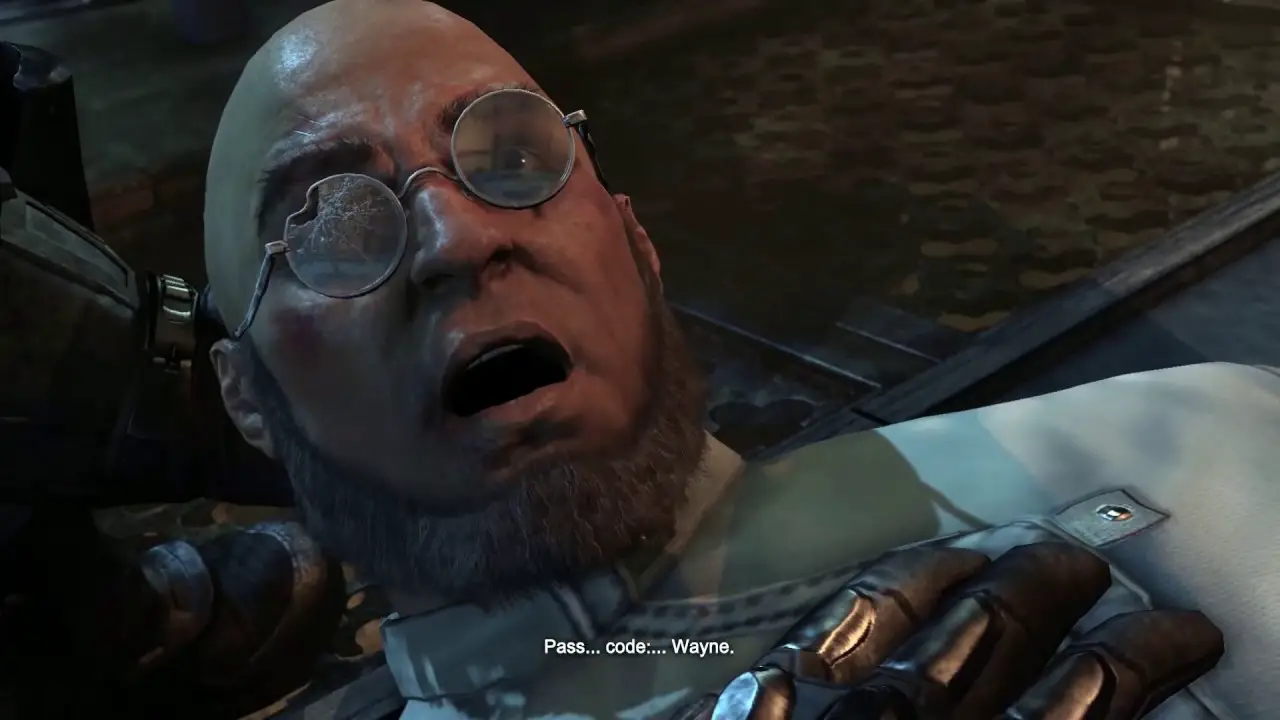
And after that brief detour to deal with the masterminds behind the entire inciting plot of the game, we now go back to the Joker (yet another thing to talk about later), who’s managed to overpower Talia and is demanding Batman come to him. He of course does, but is confused when Joker demands the cure, and even more when Talia stabs Joker, but fails to make him bleed. The first is answered when Talia reveals that she stole the cure from Harley after Harley stole it from Freeze. The second is answered after a still dying Joker shoots Talia from the balcony above, revealing that the Joker Talia stabbed, the healthy one, has in fact been the shapeshifter Clayface (Rick D. Wasserman), helping Joker keep up appearances.
Clayface grabs the cure from where Talia dropped it, and a battle between Batman and Clayface ensues, relying largely on gadgets and Talia’s sword due to the villain’s nature as living clay. At the end of it all Batman wins, drinking some of the cure. When Joker demands the cure, Batman muses about how saving Joker will just get more people killed, causing Joker to attack him, shattering the cure vial in the process. Batman admits that if Joker hadn’t attacked him, he would have given him the cure despite the man’s evil, which Joker admits makes his self-destruction pretty funny, and the game ends with Batman solemnly carrying Joker’s body out of Arkham City.
The Technical Side of Things

The art direction of Arkham City is honestly fantastic. The prison itself feels grimy, worn down and cold, but also lived in and vibrant. Penguin’s museum and Joker’s steel mill both feel perfect for their characters, creepy and distinct. While the sheer number of complex Riddler puzzles feels hard to believe (we’ll talk about that when we deal with side quests) the mechanisms look believably industrial and brutish for the situation.
The character design is…largely good. Batman is of course distinct by now, but with some design flourishes that make him distinctly Arkham’s Batman. Same with Joker. Penguin, Two-Face, Riddler, Strange, Ra’s, they all look creative, distinct, and fitting for their character. Mr. Freeze honestly looks the best he’s ever looked.
…that being said, we need to talk about the women. Vicki Vale looks fine in her brief appearances, dressed practically for the weather. But the rest? Catwoman, Talia, and Harley are all clad in tight leather that shows plenty of cleavage, with Talia and Harley showing most of their arms and a lot of stomach and hips, while Catwoman has a metal zipper running down to her crotch tight to her skin. In the middle of winter. While it’s snowing. There are chunks of ice in the harbor. Poison Ivy might be worse, wearing just a mostly unbuttoned blouse and a pair of panties made of leaves, but at least she has the excuse of staying inside in her humid indoor jungle all the time. While I understand that comics are rarely great at designing their women practically, this is excessive. The Arkham games are often credited as being responsible for Harley’s transition from a clown aesthetic to a more sexual one, and given that her first appearance in the game has her modeling herself and flaunting her body at Batman I can’t really argue. And for a serious assassin Talia’s gear is confusing.
On a more pleasant topic, the voice acting is, much like the art design, excellent across the board. Admittedly, Tara Strong as Harley is perhaps a bit too purposefully grating, but otherwise everyone is quite good. Kevin Conroy and Mark Hamill are, of course, excellent as Batman and Joker, but the whole cast is very talented and sell their characters and emotions quite well.
The Problem of the Joker
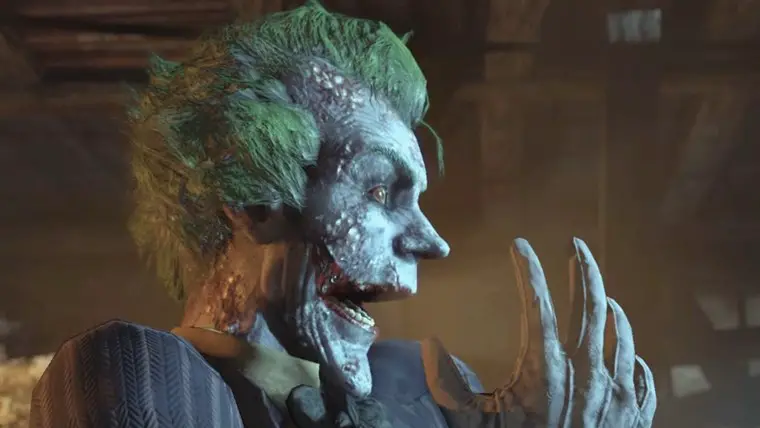
Arkham City is a fantastic game. But it’s also a flawed one. We discussed one of the major flaws of the game above, the design of the women, but now let’s discuss another one before moving to the side content. Rocksteady, rather infamously, has a bit of an obsession with the Joker. In Arkham Asylum it worked, as everything that went wrong hinged on the Joker’s plan. In Arkham City it works…less well.
The game is called Arkham City for a reason. The titular prison was built by Hugo Strange, the man who managed to figure out Bruce’s identity on his own, who persuaded Ra’s al Ghul to give him a blank check, who built a private army and managed to get almost all the super villains under his control, playing them against each other and manipulating them to further his own goals. And while it’s understandable that he’s not a physical threat, the fact that he only really appears in the opening and penultimate scenes, that after he’s dealt with we immediately refocus on Joker with no sense of triumph or grand victory, is narratively weak. The game views the man responsible for the entire plot of the game as ultimately just a distraction from the Joker.
And while it’s entirely understandable to have the poisoning of Batman by the Joker taking importance in the plot, since…y’know…it’s literally killing him, the fact that this happens so quickly means it overshadows everything else. You don’t deal with Penguin because he’s a threat, or because he’s a villain, you deal with him because he’s an obstacle in trying to stop the Joker. Batman tracks down Ra’s and the League of Assassins, not because having the leaders of an assassin’s guild under Gotham is a problem but because he needs to use them to stop the Joker. Harley isn’t a threat, and isn’t even worthy of respect, because she’s nothing compared to the Joker. Ivy’s in Arkham City, but we can’t even notice her as Batman because we have to keep the Joker as the biggest threat. Talia, a skilled and competent assassin, has to be saved from the Joker because he’s just so wily and unpredictable she can’t handle him. Clayface wasn’t even supposed to be in Arkham City, but snuck in to play the Joker because he thinks the Joker is just that awesome.
Every villain involved in the main plot, every chunk of the story, is dominated by the Joker. In Asylum that was the case, but that was because in that game Joker initiated the breakout and riot that started everything. Joker was our Strange in the first game, but now he’s taken control of the plot here too, when he really shouldn’t.
That being said…it’s Mark Hamill’s Joker, so he’s still a ton of fun. The missions dealing with the other villains are distinct enough and engaging enough that you’re able to forget the problems above while playing. And, honestly, the Joker’s death is a masterpiece, a very fitting end for the character. So while thematically and narratively this is a problem, it’s not inherently a deal breaker.
Side Quests
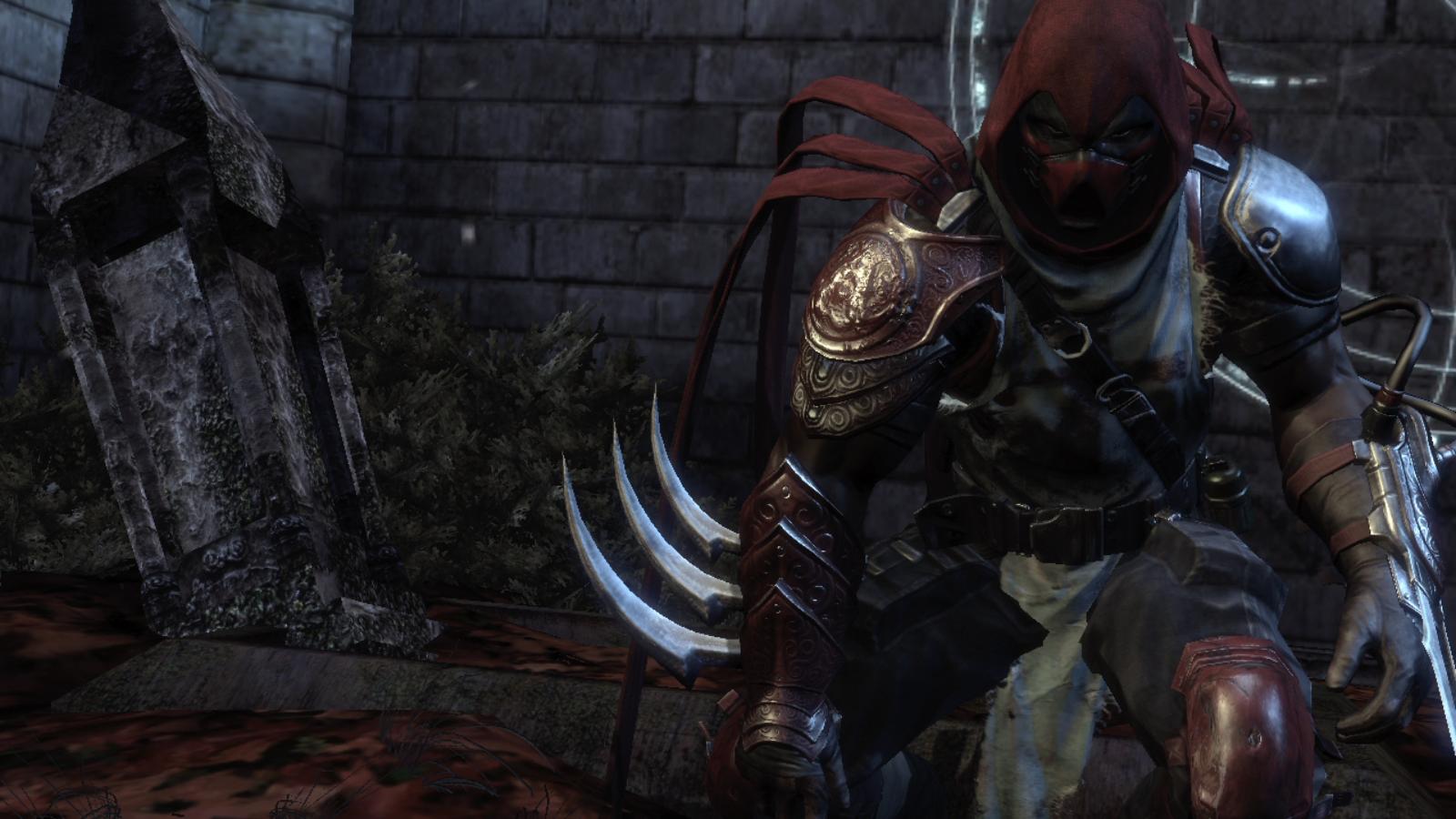
Arkham City is a wide open sandbox with equipment upgrades and an XP system. So you know what that means! Side Quests! The game has twelve in total, ranging from the pointless to the fascinating to the tedious.
Three, the AR Training, the retrieval of Freeze’s equipment from Joker’s boiler room, and visiting the cops who take over Penguin’s lounge after you beat him, give you equipment and so are definitely worth your time. The quest to save political prisoners is long and a bit tedious to complete, but makes you feel heroic and gives a decent amount of XP. If you enjoy the traversal mechanics, gliding and zipping through the air and from high points, then Zsasz’s side quest (undertaken by answering ringing payphones) is for you. If you want to do some detective work while playing as The World’s Greatest Detective…then you’ll need to play Arkham Origins. But if you can’t do that, then the Hush, Azrael, and Deadshot side quests are for you. Bane’s side quest ends poorly, but can easily be completed while doing the story, so it’s best to start after getting poisoned by Joker.
And if you want to tear your hair out and growl a whole lot, boy, do I have the side quest for you! The only side quest that the story requires you to begin, the Riddler mission! -Insert long sigh here-
Riddler’s Nonsense
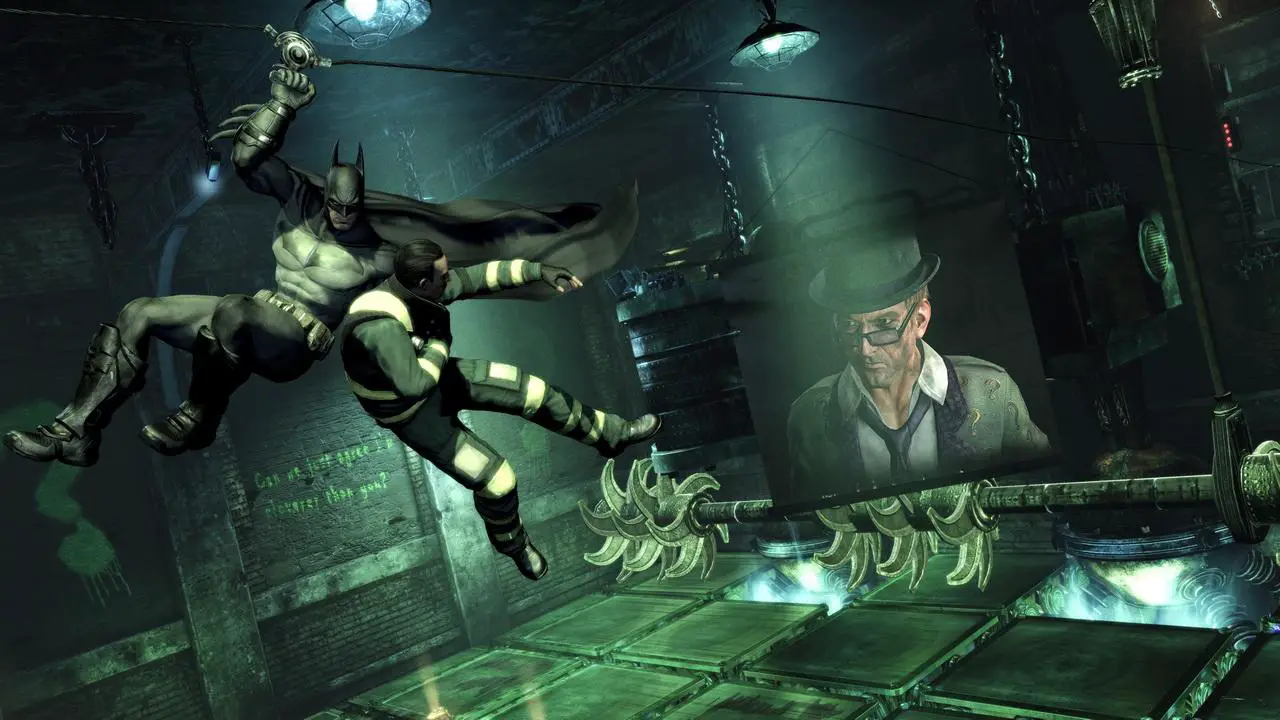
Okay, I’m not opposed to having the Riddler’s collectible driven side quest. Arkham’s Riddler is fun, and it’s cathartic to thwart him and cause him to break down. I had a lot of fun solving his riddles and collecting his trophies in Asylum. But, there are two big problems with the Riddler here in City. First, there’s too many Riddler challenges. In Asylum there were two hundred and forty, scattered around the game’s modest map. In contrast, City has four hundred and forty. And while City’s map is larger, we have the second problem.
Getting the Riddler challenges done is just generally more tricky. For one, the trophies got more elaborate. Now for a good chunk of them, puzzles have to be solved, gadgets have to be used in unorthodox ways you never need to in the plot, and you have to make a lot of noise. Which, since City has respawning enemies, many with guns, unlike Asylum, that’s a problem. Now, part of the problem is just that I’m not the best at puzzles. It’s not how my brain is wired. I consider it an accomplishment if I can beat a Portal room without a walkthrough. Still, it’s just too much and too many, not helped by the number of them that can only be picked up when playing as Catwoman. Speaking of which!
The Catwoman DLC
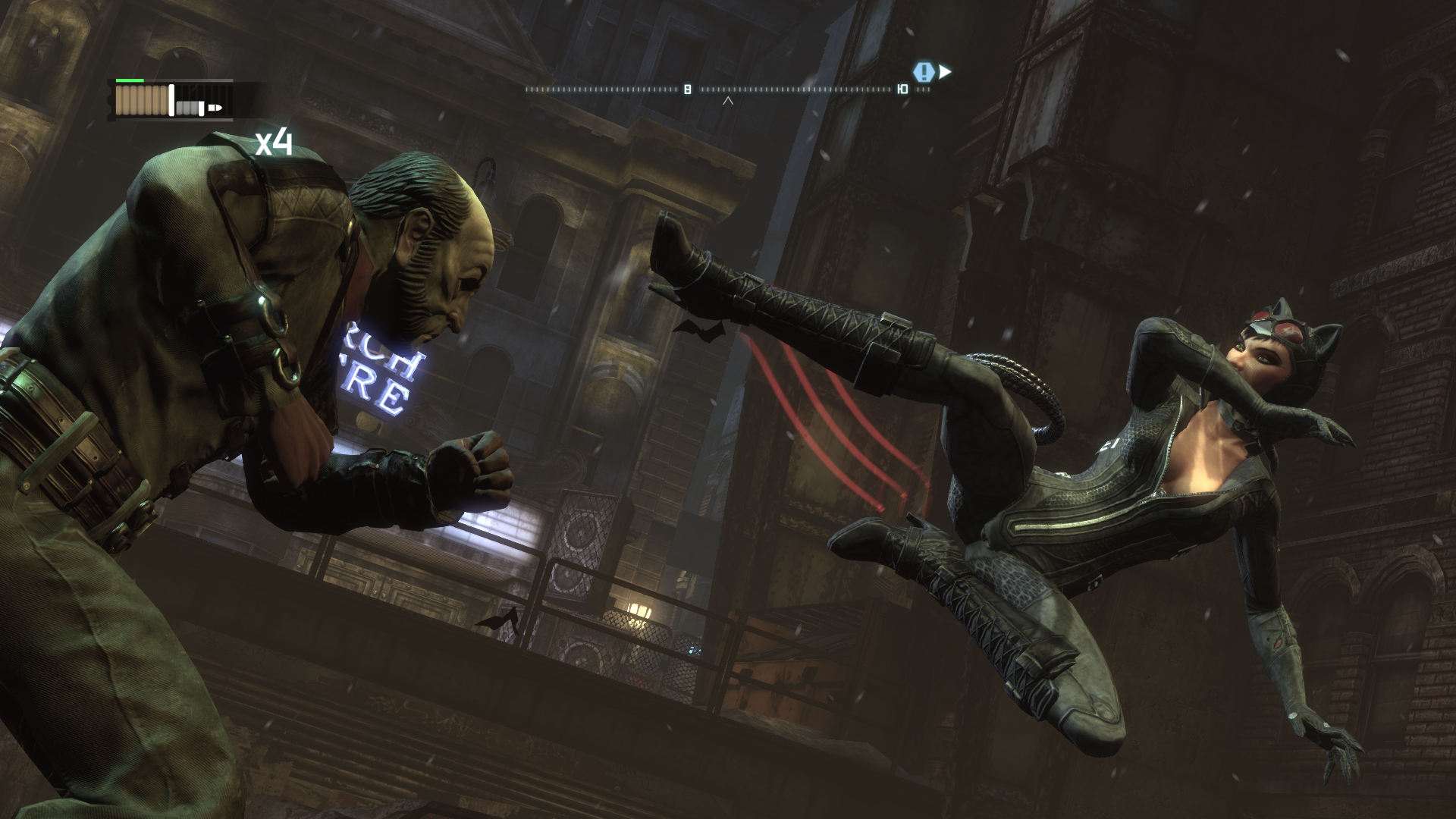
Available as DLC, or for free with the Game of the Year and Return To Arkham editions of the game are a series of missions where you play as Catwoman. The first combat section of the game has you playing as her in fact, as does the last, and there’s two more segments seeded throughout the game, moments where Batman gets knocked out and so we transition to play through what Catwoman’s up to.
I have mixed feelings about this. Let’s talk about the negative first, so we can end this segment on a high note. For one thing, Catwoman needs to be upgraded like Batman does, feeding from the same XP pool. And while Catwoman does contribute to that XP pool, she only have a few playable sections before the post game and you can switch between the two, so she doesn’t do much. But if you want to give her decent health, you’re going to have to hold off on upgrading the main character to upgrade her instead. And for another, Catwoman’s traversal is…slow, and kinda anxiety inducing. She doesn’t glide, but instead jumps from perch to perch, necessitating a series of quick time events. And since most of her segments require a decent bit of travelling, that can be a pain.
On the other hand though, the story beats with her are interesting (she’s the only reason Poison Ivy has a presence in the game), she can climb on the ceiling for stealth, and I love her combat. Playing through this game over the week for this article. I was shocked to realize just how more in control I felt when fighting groups of enemies than I did as Batman. Everything Catwoman does is fast, and that speed gives her a control of the battlefield that Batman just doesn’t have. While I am cautiously optimistic for Suicide Squad: Kill the Justice League, I honestly would be down for an entire game as this style of Catwoman. So yeah, while Catwoman brought some frustrations, she also brought a lot of positives, and I think she was ultimately a good addition to the game. Now, let’s talk about the other DLC before wrapping this up.
Harley Quinn’s Revenge, aka the Robin DLC
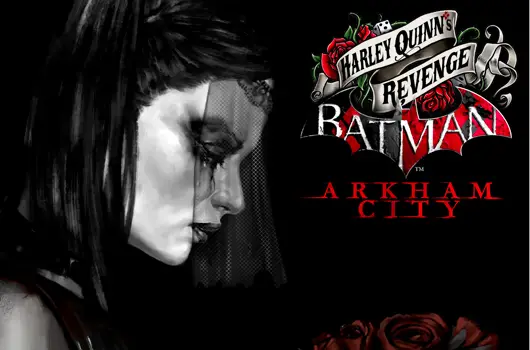
And now we come to the last bit really worth discussing. There are some combat and stealth challenge rooms you can unlock, but those are just more gameplay. Fun, but not much for me to talk about. So instead we’re going to focus on this little adventure. And I do mean little, the thing can be beaten in an hour. Set a few weeks after Arkham City’s main plot, you play as Robin (the Tim Drake version specifically, voiced by Troy Baker) investigating the steel mill. Harley Quinn refuses to leave, has taken hostages, and now managed to capture Batman, trapping him. As Robin you must save him, exploring the steel mill with his gadgets to rescue your mentor.
It’s not terrible, Robin has a few unique gadgets, most notably a collapsible shield that lets him defend against bullets. There’s nothing really special to it narratively, but if you like Robin, hate Harley Quinn, or just want some more Arkham gameplay it’s not a bad way to kill an hour, and like the Catwoman DLC it’s free with the Game of the Year and Return To Arkham versions.
Final Thoughts
For all my gripes, I still love this game. I had a ton of fun plying it for this article. The gameplay still holds up, the voice acting and art design is excellent, it has one of the best boss fights ever in Mr. Freeze, the Clayface twist with Joker is actually pretty damn good, and while it’s undeniably flawed it respects the player’s time and intelligence more than most sandbox games even now. If you like action sandboxes or superheroes give it a play, you won’t be disappointed.
Image courtesy of WB Games & Rocksteady Studios
Have strong thoughts about this piece you need to share? Or maybe there’s something else on your mind you’re wanting to talk about with fellow Fandomentals? Head on over to our Community server to join in the conversation!

